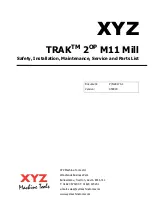
© Microhard Systems Inc.
135
6.0 Installation
6.2.2 Coaxial Cable
The following types of coaxial cable are recommended and suitable for most applications
(followed by loss at 2.4GHz, in dB, per 100 feet):
LMR 195 (10.7)
LMR 400 (3.9)
LMR 600 (2.5)
For a typical application, LMR 400 may be suitable. Where a long cable run is required - and in
particular within networks where there is not a lot of margin available - a cable with lower loss
should be considered.
When installing cable, care must be taken to not physically damage it (be particularly careful with
respect to not kinking it at any time) and to secure it properly. Care must also be taken to affix the
connectors properly - using the proper crimping tools - and to weatherproof them.
6.2.3 Surge Arrestors
The most effective protection against lightning-induced damage is to install two lightning surge
arrestors: one at the antenna, the other at the interface with the equipment. The surge arrestor
grounding system should be fully interconnected with the transmission tower and power ground-
ing systems to form a single, fully integrated ground circuit. Typically, both ports on surge arres-
tors are N-type female.
6.2.4 External Filter
Although the Pico Series is capable of filtering-out RF noise in most environments, there are cir-
cumstances that require external filtering. Paging towers and cellular base stations in close prox-
imity to the pX2’s antenna can desensitize the receiver. Microhard Systems Inc.’s external cavity
filter eliminates this problem. The filter has two N-female connectors and should be connected
inline at the interface to the RF equipment.
Direct human contact with
the antenna is potentially
unhealthy when a pX2 is
generating RF energy.
Always ensure that the pX2
equipment is powered down
(off) during installation.
To
comply
with
FCC
regulations, the maximum
EIRP must not exceed
36dBm.
A l l
i n s t a l l a t i o n ,
maintenance, and removal
work must be done in
accordance with applicable
codes.







































